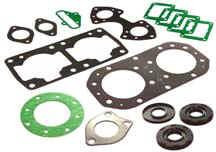How To Choose The Right Gasket Material For Your Project?
There are many factors to consider when choosing the right gasket material for your project. The type of application, the operating conditions, and the required sealing performance all play a role in selecting the appropriate gasket material. With so many options available, it can be difficult to know where to start. This essay will provide an overview of the most common gasket materials and their applications, to help you choose the right gasket material for your project.
Rubber Gaskets:
Rubber gaskets are one of the most versatile gasket materials, and are suitable for a wide range of applications. They are available in a variety of elastomers, including neoprene, nitrile, and silicone. Rubber gaskets provide good sealing performance and can withstand moderate temperatures and pressures.
Fiber Gaskets:
Fiber gaskets are made from a variety of materials, including asbestos, graphite, and non-asbestos composites. They are suitable for use in high-temperature and high-pressure applications. Fiber gaskets provide excellent sealing performance and are resistant to chemical attacks.
Sheet rubber:
Sheet rubber is a type of rubber that is produced in large, thin sheets. It can be made from natural or synthetic rubber and is often used in a variety of industrial and commercial applications.
Some common examples of sheet rubber include:
-Gaskets
-Seals
-Packings
-Insulation
-Vibration dampening
Sheet rubber is often used because it is easy to work with and can be cut to fit a variety of applications. It is also durable and has good resistance to a variety of chemicals and temperatures.
Shaft seals:
Shaft seals are an important component in many types of machinery. They help to keep lubricants in and contaminants out and can prevent leaks and excessive wear. There are many different types of shaft seals available, and the best type for a particular application depends on some factors. Some common considerations include the type of shaft, the operating environment, the type of lubricant, and the desired level of sealing performance.
Compression packing seals:
Compression packing seals are used to seal various types of joints, connections, and openings. They are commonly used in plumbing and piping applications, as well as in HVAC systems. Compression packing seals are available in a variety of materials, including rubber, plastic, and metal.
Conclusion:
There is no one-size-fits-all gasket material. The right gasket material for your project will depend on the specific application and operating conditions. This essay has provided an overview of the most common gasket materials and their applications. With this information, you should be able to choose the right gasket material for your project.





Comments
Post a Comment